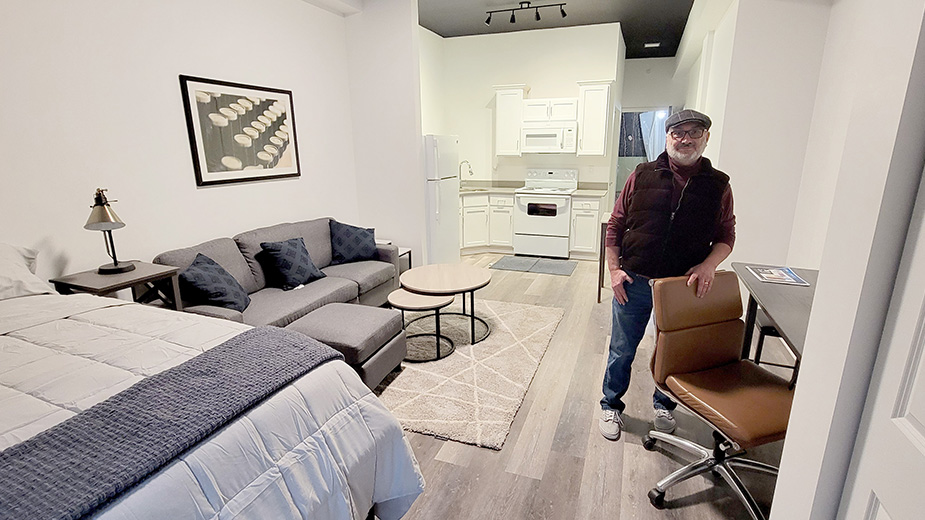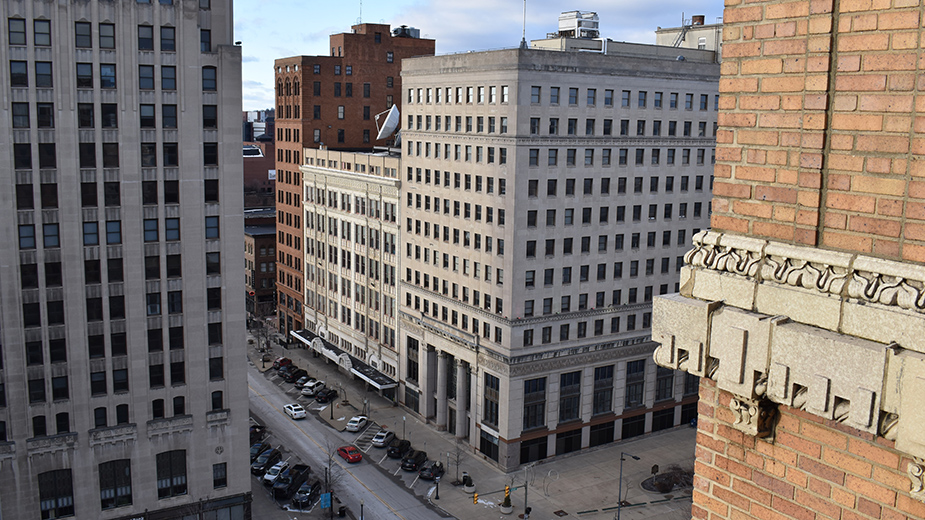YOUNGSTOWN, Ohio – Deanna Rossi, branch office supervisor of the Transamerica Financial Advisors office in downtown Youngstown, has been an enthusiastic resident of the city’s central business district for the past decade.
Her daily commute to work is a brisk walk from the Realty Tower across Market Street to her office in the Metropolitan Bank Tower.
“I thought I was going to be here temporarily, and now I’ve been here for 10 years,” she says. “I fell in love with it.”
John Angelilli, property manager for Greenheart Companies, understands that the notion of living in downtown Youngstown raises eyebrows among people of a certain age.
“For us older people, it’s hard to say and believe it,” he says. “But people just love being right in the center of things.”
That movement to be “in the center of things” is a trend that downtown Youngstown has experienced for at least a decade.

It coincides with a parallel trend in recent years of tall empty buildings that had been designed for business offices and housed dozens – if not hundreds – of workers, managers and executives.
Angelilli’s company is in the process of completing its renovation of the Gallagher Building downtown, where it will have 41 units ready for occupancy March 1. Plans call for a ground-level dining and entertainment venue to open May 1.
As of early January, 31 parties had expressed interest in the available units, with signed leases for two and another three pending.
DOWNTOWN DRAW
Downtown Youngstown isn’t an anomaly. Across the country, the pandemic hollowed out office buildings as businesses shifted to remote or hybrid work models, options that many companies have retained as the pandemic eased.
The New York Times reported in December that more than 998 million square feet of office real estate is available nationwide, with property owners across the country looking to convert some of that vacant space into apartments.
And while remote work has led to the emptying of downtown offices, the option has made smaller metropolitan areas more attractive for residential living, particularly in downtowns.
The residential population of downtown Youngstown has grown over the past decade as tenants filled properties such as Erie Terminal Place, Realty Tower, Wick Tower and the Federal Building.
Downtown draws include the cluster of restaurants and bars; development of entertainment venues such as Covelli Centre, Youngstown Foundation Amphitheatre and Wean Park; proximity to Youngstown State University; and a street improvement project that, while now causing inconveniences for downtown travelers and business owners, is aimed at creating a more walkable and bikeable environment.
“Those are all things that people like,” Angelilli says.
‘THE PLACE TO BE’
In 2013, Rossi was a single mother who couldn’t find a house she wanted when downtown options were brought to her attention. Being able to work, shop, eat and play in a walkable environment allowed her to spend more time with her two children, so she moved her office from Boardman to downtown.
She also likes not having to worry about yard maintenance and feels more of a sense of community downtown than in any of the other neighborhoods where she has lived before.

“There is an amazing sense of community among the residents and business owners,” Rossi remarks. People from restaurant owners and police officers to architects, attorneys, the mayor and the university president greeted her children on the way to school.
“They were all invested in them and wished them a great day, like we were on Sesame Street,” she says.
The U.S. Census Bureau reports downtown Youngstown employment has declined from nearly 8,000 in 2002 to 5,900 in 2019, the year before the pandemic.
Other census data show the downtown residential population nearly doubling over a slightly longer period, from just over 1,000 in 2000 to slightly under 2,000 in 2020.
The Gallagher Building, which a GreenHeart-related real estate entity acquired about three years ago, will offer apartments with six open-floor plans to choose from, individual heating and air conditioning units, carpeting and hardwood floors, high-speed internet and a security system.
Rental rates for the units start at $895 per month, which includes all utilities,
“Historic downtown Youngstown is the place to be for urban residential living,” Angelilli says.
HUNTINGTON BANK BUILDING
Work is poised to begin on another downtown residential project, the Huntington Bank building.
Market Street Ohio LLC, the New York-based investment group that purchased the building for $2.3 million in December, has engaged Canfield architect Annissa Neider to draw plans for the property.
The new owners envision converting the top nine floors of the 13-story tower from office space to apartments, with a potential construction start this quarter, says Neider, principal of A. Neider Architecture LLC.
“They definitely see that potential in Youngstown and how the other properties have been successful,” she says. “Most of the apartment units are in fact rented at this point. So they see that there is a market for living downtown.”
Apartment space also represents a key element for the proposed renovation of the city-owned 20 Federal Place, where environmental remediation work funded by a $6.96 million state brownfield grant is expected to begin in March.
The New York real estate investor who purchased the Chase Tower in 2021 also has expressed interest in converting up to four floors of that building for residential use.
Desmone, a Pittsburgh area architectural firm, entered into the first of a series of memoranda of understanding with city officials in late 2021 to act as the developer for 20 Federal Place.
Plans the Desmone firm outlined in November envision 154 residential units on the building’s upper levels as well as office space, food vendors and a potential grocery store on the lower levels.
A recent estimate put the cost of the Federal Place project at $96 million, substantially above earlier projections. That cost is “not set in stone” and reflects “one design iteration during one moment in time,” says Eric Booth, president of Desmone.
“We are aiming to attract people from all walks of life to experience Youngstown for many generations to come,” Booth says. Individuals and families now residing in area suburbs but “looking for a vibrant downtown experience” are particularly excited, says Booth.
The housing analysis commissioned by Desmone indicated there is “sufficient market demand” for both the 20 Federal and Huntington residential projects, according to Hunter Morrison, urban planning consultant for the city.
“What downtown offers is an opportunity for people who want to live in a multifamily environment and a walkable community,” he says. “There’s not a lot of product in the Mahoning Valley for those who want to live in a walkable environment and I think that’s one of the benefits of downtown living these developers are looking to capture.”
Mark Marvin, president of Downtown Development Group in Warren, has redeveloped and sold several residential units in that city’s downtown and regularly gets calls from people interested in downtown living. The movement to downtown living has been popular among millennials for at least a decade, he says.
Demand fell some in recent years because of concerns people had about living close to others during the height of the pandemic. But as the pandemic has eased, interest is rising, Marvin says. Marvin’s company, having sold all of its condominium units, is looking at converting spaces in a couple of buildings that have ground floor retail – making the spaces unsuitable for condo development – into apartments once it completes work on loges at the Robins Theatre, which it owns.
RECRUITMENT ISSUES
The lack of executive housing was identified during discussions with local stakeholders as the Trumbull County Tourism Bureau works though a federal resiliency and recovery grant for the travel industry. Because of that deficiency, executives coming to the area are staying in local hotels, “creating an issue for our travel industry that we can’t book additional business,” says Beth Carmichael, executive director of the bureau. Companies frequently communicate that they have difficulties attracting talent because of the lack of “urban areas and development projects” that are attractive to workers, says Shea MacMillan, vice president, economic development, for the Youngstown/ Warren Regional Chamber. Human resource directors and recruiters report they’re falling short because they can’t place candidates in suitable housing.
“We’re hearing from our largest employers that it’s their biggest challenge attracting people,” he says.
NEED FOR INCENTIVES
A key to many of the projects is often incentives. The Huntington building project received $1.2 million from the Ohio Historic Tax Credit Program to support the $12.2 million renovation.
Renovating historic buildings is often more costly than building from scratch and incentives like the state historic tax credit help offset the extra costs that come with renovating such structures, Neider says.
“Sometimes it’s the only way these buildings get renovated. Otherwise, we would have probably lost several of them over the years,” she says.
“Every major project in the country and cities like Youngstown or Pittsburgh or Cleveland has some measures of subsidy to make the numbers work,” Morrison, the city consultant, says. He points to the use of federal Urban Development Action Grants funds in Cleveland’s Warehouse District decades ago to make return on investment in that area attractive when compared to doing new construction elsewhere.
State legislators in Ohio have done “a fantastic job” creating the tools and incentives to encourage such development, MacMillan says. These include the Historic Preservation Tax Credit, which the state expanded last year, and the Transformational Mixed-Use Development Tax Credit.
EXPANDING THE MARKET
While many of the downtown living spaces are geared toward students and young professionals, Rossi suggests developing properties for independent senior living.
She acknowledges downtown living isn’t right for everyone, and urges those considering it to explore the possibilities.
“There are a lot of places they can try out for a year and decide if it is a good fit,” Rossi says. “I wasn’t planning on being here long term and I ended up getting addicted.”
Pictured at top: This is the view from the deck of an apartment in the Realty Tower, a landmark converted years ago into apartments.
